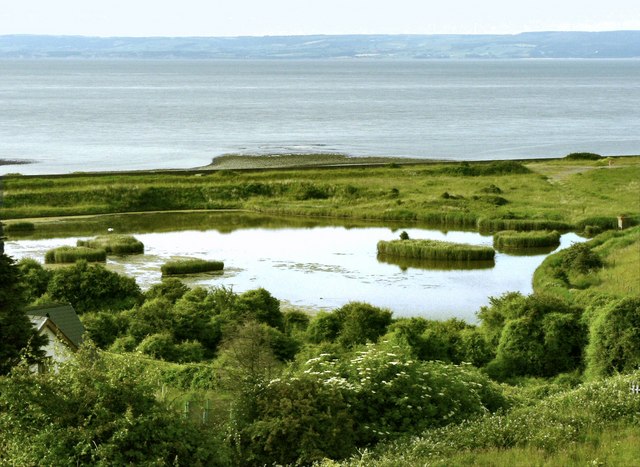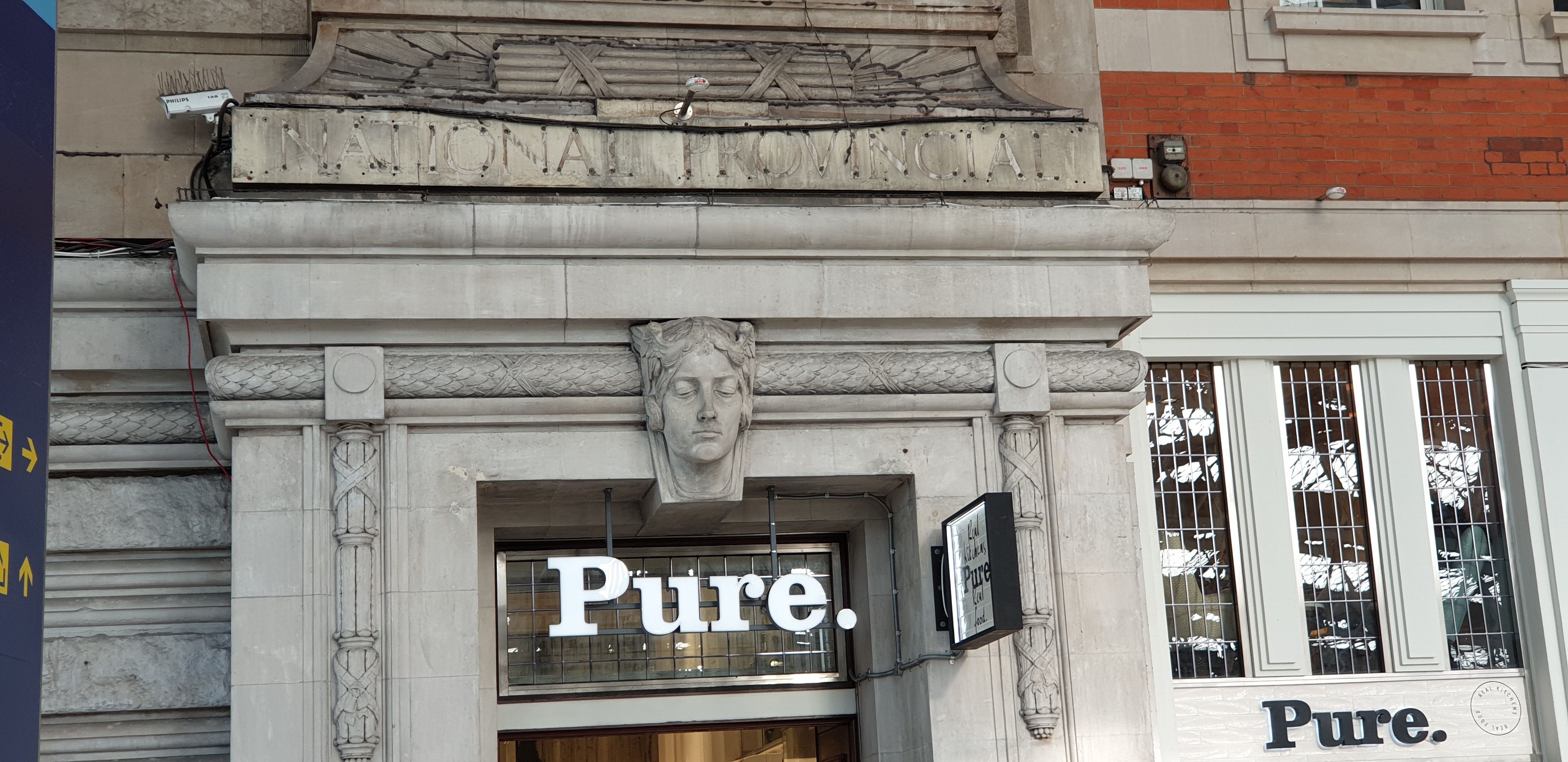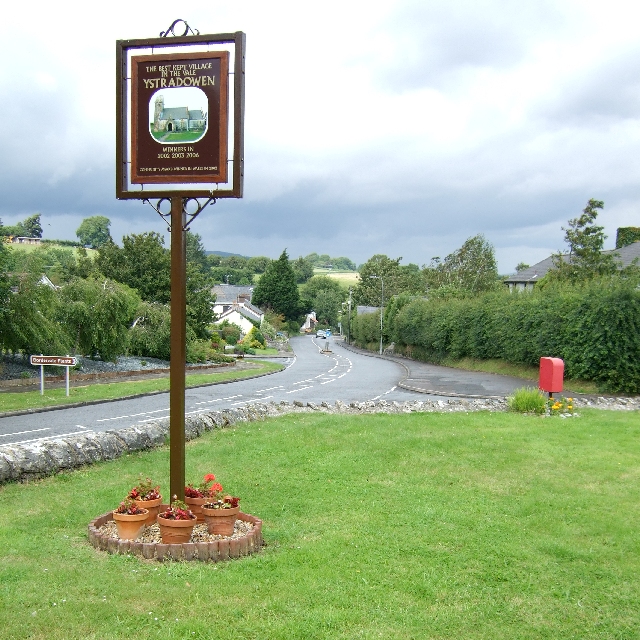|
Llantrisant–Aberthaw Line
The Llantrisant – Aberthaw line was a railway line built in two parts. The Cowbridge Railway was a locally promoted railway line in South Wales, intended to connect the town to the nearby mainline network at Llantrisant. The company was desperately short of money to construct the line and a subscription of £10,000 from the Taff Vale Railway towards the construction costs ensured alignment to that company's system, so that Pontypridd, and not Cardiff, was the destination of through passenger trains. The line opened in 1865 and operated as a through line from Pontypridd in association with the Llantrisant and Taff Vale Junction Railway. The Company was always impoverished and from 1876 leased its line to the Taff Vale Railway. The TVR absorbed the Company in 1889. High quality limestone workings at Aberthaw encouraged thoughts of a Cowbridge and Aberthaw Railway. This opened in 1892, and was absorbed by the Taff Vale Railway in 1895. The Cowbridge and the Aberthaw section ... [...More Info...] [...Related Items...] OR: [Wikipedia] [Google] [Baidu] |
Vale Of Glamorgan
The Vale of Glamorgan ( cy, Bro Morgannwg ), often referred to as The Vale, is a county borough in the south-east of Wales. It borders Bridgend County Borough to the west, Cardiff to the east, Rhondda Cynon Taf to the north, and the Bristol Channel to the south. With an economy based largely on agriculture and chemicals, it is the southernmost unitary authority in Wales. Attractions include Barry Island Pleasure Park, the Barry Tourist Railway, Medieval wall paintings in St Cadoc's Church, Llancarfan, Porthkerry Park, St Donat's Castle, Cosmeston Lakes Country Park and Cosmeston Medieval Village. The largest town is Barry. Other towns include Penarth, Llantwit Major, and Cowbridge. There are many villages in the county borough. History The area is the southernmost part of the county of Glamorgan. Between the 11th century and 1536 the area was part of the Lordship of Glamorgan. In medieval times, the village of Cosmeston, near what is today Penarth in the south east of t ... [...More Info...] [...Related Items...] OR: [Wikipedia] [Google] [Baidu] |
Milford Haven Waterway
Milford Haven Waterway (''Welsh: Dyfrffordd Aberdaugleddau'') is a natural harbour in Pembrokeshire, Wales. It is a ria or drowned valley which was flooded at the end of the last ice age. The Daugleddau estuary winds west to the sea. As one of the deepest natural harbours in the world, it is a busy shipping channel, trafficked by ferries from Pembroke Dock to Ireland, oil tankers and pleasure craft. Admiral Horatio Nelson, visiting the haven with the Hamiltons, described it as the next best natural harbour to Trincomalee in Ceylon (today's Sri Lanka ) and "the finest port in Christendom".Wing Commander Ken McKay ''A Vision of Greatness: The History of Milford 1790–1990'', Brace Harvatt Associates, 1989. Much of the coastline of the Waterway is designated as a Site of Special Scientific Interest, listed as Milford Haven Waterway SSSI. History Early history From the 790s until the Norman Invasion in 1066, the waterway was used occasionally by Vikings looking for shelte ... [...More Info...] [...Related Items...] OR: [Wikipedia] [Google] [Baidu] |
Railway Companies Disestablished In 1889
Rail transport (also known as train transport) is a means of transport that transfers passengers and goods on wheeled vehicles running on rails, which are incorporated in tracks. In contrast to road transport, where the vehicles run on a prepared flat surface, rail vehicles (rolling stock) are directionally guided by the tracks on which they run. Tracks usually consist of steel rails, installed on sleepers (ties) set in ballast, on which the rolling stock, usually fitted with metal wheels, moves. Other variations are also possible, such as "slab track", in which the rails are fastened to a concrete foundation resting on a prepared subsurface. Rolling stock in a rail transport system generally encounters lower frictional resistance than rubber-tyred road vehicles, so passenger and freight cars (carriages and wagons) can be coupled into longer trains. The operation is carried out by a railway company, providing transport between train stations or freight customer faciliti ... [...More Info...] [...Related Items...] OR: [Wikipedia] [Google] [Baidu] |
Horatio Arthur Yorke
Lieutenant-Colonel Sir Horatio Arthur York (3 June 1848 - 10 December 1930) C.B. R.E. was Inspector of Railways to the Board of Trade from 1900 to 1913. Life He was born on 3 June 1848 near New Wimpole in Cambridgeshire, the fourth son of the Ven the Hon Henry Reginald Yorke (1803-1871) and Flora Elizabeth Campbell (1813-1852). He was educated at Cheam School and then Charterhouse School. On 24 August 1869, he married Harriette Forsse in Gravesend, Kent. This marriage ended in divorce in 1891. On 26 July 1893 he married Rebecca Caroline Garstin (d.1943), daughter of the Revd. Anthony Gartin, Rector of St Peter's Church, Redmile, Leicestershire. He was appointed a Companion of the Order of the Bath in 1904 and knighted on his retirement in 1913. He died on 10 December 1930 in London and left an estate valued at £4,234 (). Military career He entered the Royal Military Academy Sandhurst in 1865. A year later, he joined the Royal Engineers and entered the Royal Military Academy ... [...More Info...] [...Related Items...] OR: [Wikipedia] [Google] [Baidu] |
Bridgend
Bridgend (; cy, Pen-y-bont ar Ogwr or just , meaning "the end of the bridge on the Ogmore") is a town in Bridgend County Borough in Wales, west of Cardiff and east of Swansea. The town is named after the Old Bridge, Bridgend, medieval bridge over the River Ogmore. The River Ewenny also flows through the town. The population was 49,597 in 2021. Historic counties of Wales, Historically a part of Glamorgan, Bridgend has greatly expanded in size since the early 1980s – the United Kingdom Census 2001, 2001 census recorded a population of 39,429 for the town and the 2011 census reported that the Bridgend Local Authority had a population of 139,200 – up from 128,700 in 2001. This 8.2% increase was the largest increase in Wales except for Cardiff. The town is undergoing a redevelopment project, with the town centre mainly pedestrianised and ongoing works including Brackla Street Centre redevelopment to Bridgend Shopping Centre, Rhiw Car Park redevelopment, ongoing public realm im ... [...More Info...] [...Related Items...] OR: [Wikipedia] [Google] [Baidu] |
Barry, Vale Of Glamorgan
Barry ( cy, Y Barri; ) is a town in the Vale of Glamorgan, Wales, on the north coast of the Bristol Channel approximately south-southwest of Cardiff. Barry is a seaside resort, with attractions including several beaches and the resurrected Barry Island Pleasure Park. According to Office for National Statistics 2016 estimate data, the population of Barry was 54,673. Once a small village, Barry has absorbed its larger neighbouring villages of Cadoxton and Barry Island, and now, Sully. It grew significantly from the 1880s with the development of Barry Docks, which in 1913 was the largest coal port in the world. Etymology The origin of the town's name is disputed. It may derive from the sixth-century Saint Baruc who was buried on Barry Island where a ruined chapel was dedicated to him. Alternatively, the name may derive from Welsh ', meaning "hill, summit". The name in Welsh includes the definite article. History Early history The area now occupied by Barry has seen human ac ... [...More Info...] [...Related Items...] OR: [Wikipedia] [Google] [Baidu] |
Vale Of Glamorgan Line
The Vale of Glamorgan Line ( cy, Llinell Bro Morgannwg) is a commuter railway line in Wales, running through the Vale of Glamorgan from Barry to Bridgend, via Rhoose and Llantwit Major. Route The Barry branch starts at Cardiff West and runs to Barry Island with a single line branch from Cogan Junction to Penarth. In June 1964, the Vale of Glamorgan line between Barry and Bridgend was closed to passengers by the Beeching Axe, as set out in the report 'The Reshaping of Britain's Railways', but after 41 years, in June 2005, it was reopened to passengers with two new stations at Llantwit Major and Rhoose, and the disused bay platform (now '1A') at Bridgend was reinstated to act as a terminus for the Vale Line. The line itself had been retained for freight traffic to/from the Ford Factory in Bridgend, and to Aberthaw Power Station, as well as to provide a detour for main line trains when the direct Bridgend to Cardiff line was closed. Network Rail's mileage from Barry Junction ... [...More Info...] [...Related Items...] OR: [Wikipedia] [Google] [Baidu] |
Aberthaw Rly
Aberthaw ( cy, Aberddawan) is an area containing the villages of East Aberthaw and West Aberthaw, on the coast of South Wales about west of Barry. It is home to Aberthaw Cement Works, Aberthaw Lime Works, and Aberthaw Power Station, a coal power station that is linked to the South Wales Valleys via the Vale of Glamorgan Railway. The area is historically within the parish of Penmark in the Vale of Glamorgan. The two villages of West and East Aberthaw are separated by the River Thaw. The village of East Aberthaw, near Rhoose, has a 13th-century pub. The village Baptist Chapel and Mission Room, no longer exist as such and have been converted for other uses. Geography Aberthaw is nearly opposite to Minehead in Somerset, England. The village of East Aberthaw is situated approximately inland from the sea. The River Thaw which meets the sea at Aberthaw is fairly small and is affected by high tides at times, and with the coming of the first coal-fired power station at Aberthaw ... [...More Info...] [...Related Items...] OR: [Wikipedia] [Google] [Baidu] |
National Provincial Bank
National Provincial Bank was a British retail bank which operated in England and Wales from 1833 until 1970 when it was merged into the National Westminster Bank. It continued to exist as a dormant non-trading company until 2016 when it was voluntarily struck off the register and dissolved. Considered one of the "Big Five," the National Provincial Bank expanded during the 19th and 20th centuries and took over a number of smaller banking companies. For most of its history it was based on Bishopsgate, at the thoroughfare's junction with Threadneedle Street, in London. It is possible to still see evidence of this bank at Waterloo Station in London, where the logo has been removed but the outline of the words remain. History National Provincial Bank of England The National Provincial Bank played a unique role in the development of commercial banking. Prior to the Act of 1826, English banks were permitted to have no more than six partners – hence the expression "private banks ... [...More Info...] [...Related Items...] OR: [Wikipedia] [Google] [Baidu] |
Ystradowen
Ystradowen is a small village twelve miles west of Cardiff, located in the Vale of Glamorgan in south Wales; its nearest town is Cowbridge which is about three miles to the south. The village was served by Ystradowen railway station between 1865 and 1951. The name Ystradowen means "Owen's Valley" in English. Local amenities include St Owain's parish church, The White Lion public house A pub (short for public house) is a kind of drinking establishment which is licensed to serve alcoholic drinks for consumption on the premises. The term ''public house'' first appeared in the United Kingdom in late 17th century, and was ..., Tudor Garage and Seven Oaks fisheries. Notable residents: Tom Jones had a home in the village until 1998. References Villages in the Vale of Glamorgan {{ValeofGlamorgan-geo-stub ... [...More Info...] [...Related Items...] OR: [Wikipedia] [Google] [Baidu] |
Board Of Trade
The Board of Trade is a British government body concerned with commerce and industry, currently within the Department for International Trade. Its full title is The Lords of the Committee of the Privy Council appointed for the consideration of all matters relating to Trade and Foreign Plantations, but is commonly known as the Board of Trade, and formerly known as the Lords of Trade and Plantations or Lords of Trade, and it has been a committee of the Privy Council of the United Kingdom. The board has gone through several evolutions, beginning with extensive involvement in colonial matters in the 17th century, to powerful regulatory functions in the Victorian Era and early 20th century. It was virtually dormant in the last third of 20th century. In 2017, it was revitalised as an advisory board headed by the International Trade Secretary who has nominally held the title of President of the Board of Trade, and who at present is the only privy counsellor of the board, the other m ... [...More Info...] [...Related Items...] OR: [Wikipedia] [Google] [Baidu] |
Llanharry
Llanharry ( cy, Llanhari) is a village, Community (Wales), community (civil parish) and electoral ward in the county borough of Rhondda Cynon Taf, Wales. Historic counties of Wales, Historically part of Glamorgan, Llanharry has been inextricably linked with iron mining as far back as the Roman period, and for a period in the 20th century it boasted the only iron mine in Wales. The town is infamous for being the site of the murders of Harry and Megan Tooze, which remain some of Wales' most notorious unsolved murders. Employment Llanharry iron mine worked from the early 1900s but closed in 1976; its main ore was goethite, which was used at the local ironworks. Since the closure of its mines and ironworks, Llanharry has been in economic decline, as are most South Wales Valleys villages once dependent on heavy industry. Llanharry's proximity to the M4 motorway in Wales has allowed its residents opportunities to commute to work more easily rather than seeking work locally. Llan ... [...More Info...] [...Related Items...] OR: [Wikipedia] [Google] [Baidu] |









